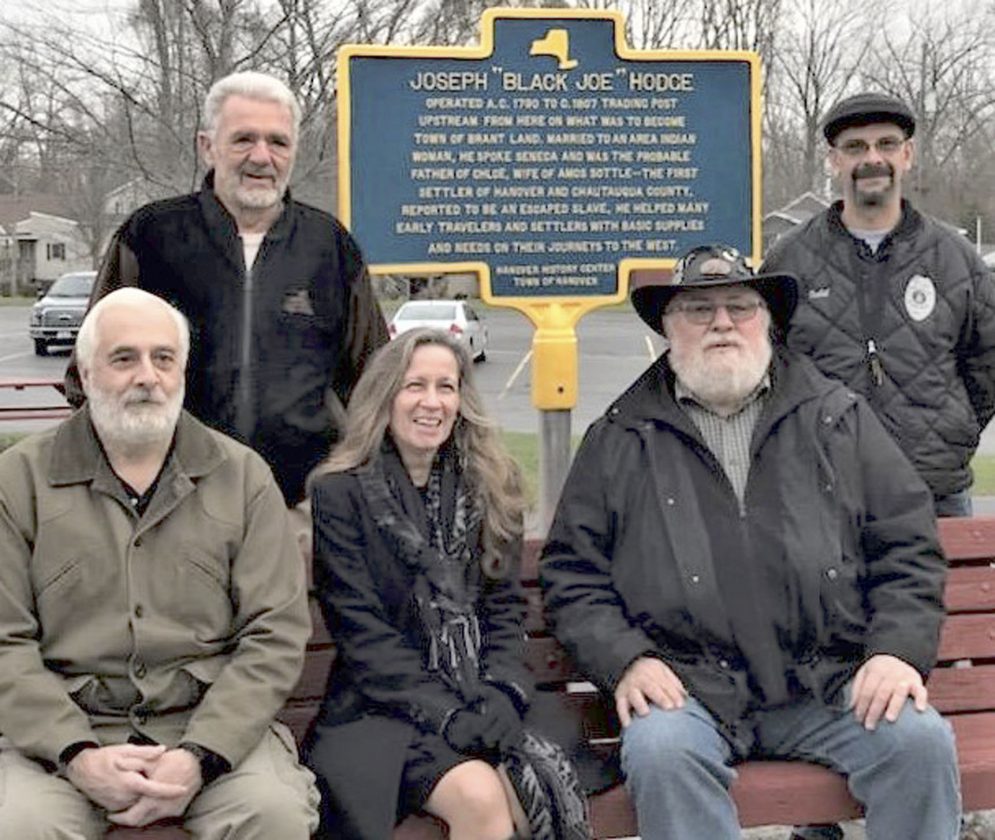‘Black Joe’ important part of local history

Submitted Photo Pictured is the Joseph “Black Joe” Hodge historical marker. Individuals in the picture are (seated): Lou Pelletter, Hanover Councilman; Patty Friend, Brant Historian; Vince Martonis, Hanover Historian. (Standing): Ed Schintzius, Hanover Councilman; Todd Johnson, Hanover Supervisor.
SUNSET BAY — Hanover Historian Vince Martonis marked another important piece of area history. Take a trip to the Hanover Boat Launch in Sunset Bay to see the Joseph “Black Joe” Hodge New York State historical marker.
One must step back into the late 1700s to learn about Hodge, who is allegedly a former slave. The Encyclopedia of Cleveland History notes that Hodge was captured by Seneca during the Revolutionary War and lived with the Indians until 1784. It also notes that he worked for the Moses Cleaveland [sic] Western Reserve survey party in 1796 and guided them from Buffalo to about Conneaut Creek in Ohio. This is the same survey team which Amos Sottle worked with for 13 weeks.
In 1791, he is recorded as managing an Indian store with Cornelius Winne at Buffalo Creek. These two men are recognized as the first settlers of Buffalo, though Hodge was there years before Winne arrived. His name often comes up in historical records from that time. By 1792 he was operating at Cattaraugus Creek, either as a trader at the Indian village at the mouth of the creek or farther up the creek on what was to become Town of Brant land at his Trading Post.
He successfully trapped game in the area and was conversant in Seneca, so he became an important resource for settlers traveling west. His Trading Post stocked valuable supplies for travelers, as well as something to eat and drink right then. He also provided one other commodity — information — more valuable than food at times.
Deacon Chamberlain from the Genesee River area spoke about Hodge when he traveled to his lodging at the mouth of Cattaraugus Creek in 1792. He records Hodge as living with an Indian woman and a young white girl dressed like an Indian. Chamberlain notes that “Joe treated us with so much civility . . . .”
Hodge is later recorded in a list of names of settlers living in Buffalo in 1806, apparently having given up his Cattaraugus Creek Trading Post, and a notation says that “Black Joe lived in a small log shanty, situated on the flat near Little Buffalo Creek [and he] kept a low class groggery.” Hodge had a son who was killed during the War of 1812, serving most likely alongside Amos Sottle who did two terms in the war.
Hodge is most probably the father-in-law of Amos Sottle, the first white settler of Chautauqua County. He had an Indian wife, and he was operating his Trading Post when Sottle arrived at the Cattaraugus Creek area in 1796. It is reported in multiple sources that Sottle’s wife Chloe was decidedly black but that she had Indian features. The two men lived in the same area. Sottle, like Hodge, had a close relationship with the Indians living at Cattaraugus Creek. Both men worked for the Western Reserve survey team in 1796 but returned home to the Hanover/Cattaraugus Creek area where they had made their homes.
Hodge may have moved to Canada for a time, but he is said to have died at an advanced age on the Cattaraugus Reservation. His gravesite is unknown.




